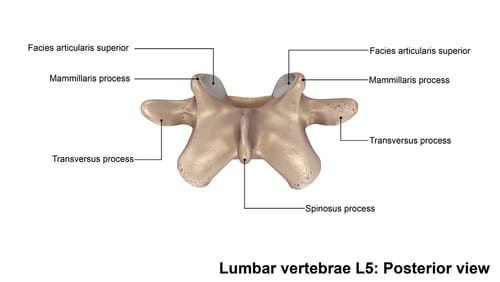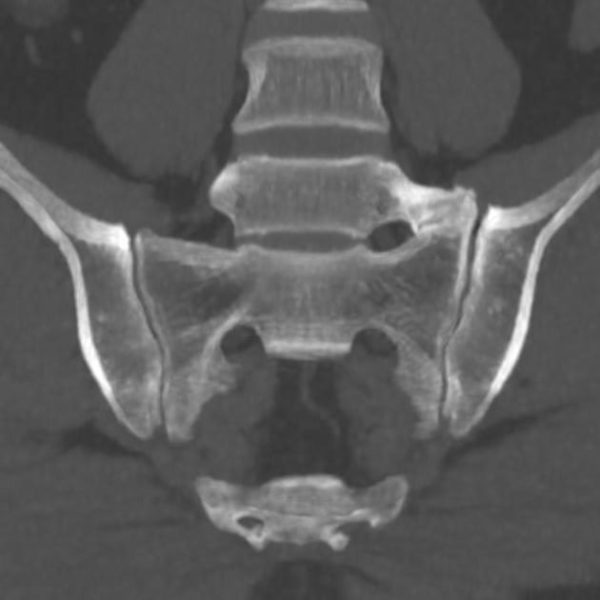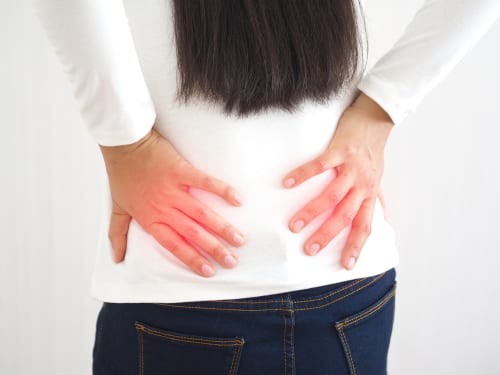What is Bertolotti Syndrome?
Upwards of 80 percent of adults experience low back pain at some point in their lifetimes. Sometimes, this pain is the result of disc degeneration, strain from overuse or poor lifting, or perhaps from a fall or injury.
In other cases, however, the pain may be the result of a congenital abnormality. Most people have five lumbar vertebrae. They are mobile and not attached to the sacrum. In 1917, Dr. Mario Bertolotti determined that in some patients, the transverse process on the last lumbar vertebra (L5) is elongated. The transverse process is the small bony projection on the right and left side of each vertebra.

L5 Anterior View Showing Normal Transversus Process 
L5 Posterior View Showing Normal Transversus Process
Because this bony projection is larger than usual, it can “fuse” with the sacrum. The sacrum is the triangular bone in the lower back, that attaches the spine to the pelvis. When the L5 is connected to the sacrum, it is not mobile. This puts more stress on lumbar vertebrae above it (L3-4 and L4-5) and on the joints below (the sacro-iliac joints).

Some call Bertolloti Syndrome “a partially sacralized L5” but it falls into a broader category known as transitional anatomy or Lumbosacral Transitional Vertebrae (LTSV). Anatomic variation in the spine is fairly common, i.e., a partially sacralized L5 is more common in males and a lumbarized S1 is more common in females. Studies indicate that 10 to 25 percent of people have some type of variation in their backbone anatomy. Many people are not aware that they have an anatomic variation because they do not have low back pain. In some patients, however, the change in anatomy can cause wear and tear in the structures of the lower back that can result in pain.
Symptoms of Bertolotti Syndrome or LSTV
Patients with Bertolotti Syndrome sometimes report lower back pain that radiates from the sides of the waistline. The pain may be mistaken for sacroiliac joint pain, lumbar disc or lumbar facet joint pain or may be associated with these other pain generators.

For reasons that are not entirely clear, many patients with Bertolotti Syndrome begin to experience pain while in their 20s and 30s. In older patients, arthritic changes or nerve irritation may trigger lower back pain from their atypical anatomy.
Reasons for Pain from Bertolotti Syndrome
There are several causes of pain as a result of Bertolotti Syndrome. Some patients may have a combination of causes. Some report that their pain alternates depending on activity. Pain can come from:
- Facet joints. Because the L5 is attached to the sacrum and that segment is not mobile, there is more stress on the segments above, especially L4-5. Over time, these joints can become swollen, inflamed and arthritic.
- Sacroiliac joint and adjacent ligaments. An imbalance in the structure of the lumbar vertebrae where it connects to the sacrum and iliac bone can create greater stress on the sacroiliac joint. The joint can become inflamed and arthritic.
- The “pseudo-joint.” When the L5 transverse process (or the backbone) touches the sacrum, it can create a “pseudo-joint” if not fully fused. Unlike regular joints, this joint does not have cartilage to cushion the impact of the bones touching each other. There is no joint fluid to lubricate and absorb shock. The result is swelling and degeneration that leads to pain.
- The disc and nerve. Greater impact at the L4-5 level above the pseudo-joint may lead to increased risk of disc degeneration and/or disc herniation. This disc and nerve root pain may cause pain in the back, as well as in either or both legs.
- Neighboring muscles. Anatomical variation can result in asymmetric forces on nearby muscles. Often one side of the back has more muscle spasm, although both sides can be affected. Muscle tightness and spasm in the region of the lower back and pelvis can lead to feeling of stiffness and pain, especially with transitional movements, like arising from a chair or getting out of bed.
Treatment for Bertolotti Syndrome
Depending on who you read, Bertolotti Syndrome can affect 10-12 percent of the population. Many people with this skeletal abnormality will not experience pain or discomfort, but those who do are likely to have significant lower back pain that can be severe enough to significantly impact their daily living and cause them to seek treatment.
Bertolotti Syndrome is very treatable. A thorough physical exam will include efforts to recreate movement that triggers the pain. A simple x-ray of the lumbar spine, with special focus on the lower vertebrae and the sacral area, can quickly identify this abnormality.

Once a diagnosis has been reached, there are numerous conservative and minimally invasive interventions which can reduce, and in some cases, eliminate the pain.
Over-the-counter anti-inflammatories (Aleve or Advil), rest or lifestyle modification to address the pain can be recommended. Injections of corticosteroid medications into the joints or along the nerves. Your treatment plan might also include structured physical therapy.
Other interventions include medial branch blocks and radio frequency ablation/neurotomy and or sacroiliac joint injections may be utilized to block the pain signals. Neurotomy involves using radio waves converted to thermal energy (heat) to deaden nerve endings around the joints that are producing the pain signals. Regenerative treatments such as prolotherapy and platelet rich plasma therapy and may be excellent non-surgical options.
Is it Really a Syndrome?
Some would argue it’s not, as LSTVs are considered a normal variant. It may not always result in pain either but patients with LTSV may be more likely to have persistent lifestyle-limiting lower back pain.

Eduardo Elizondo
MDBoard-Certified Physical Medicine & Rehabilitation
Board-Certified Electrodiagnostic Medicine
Certified Life Care Planner



